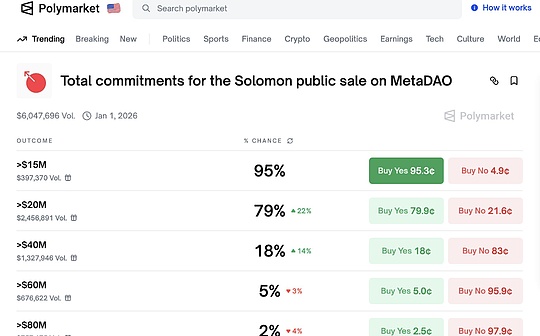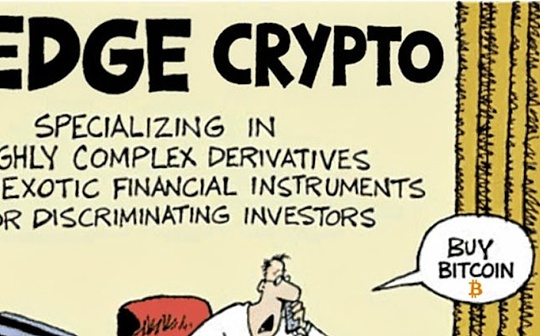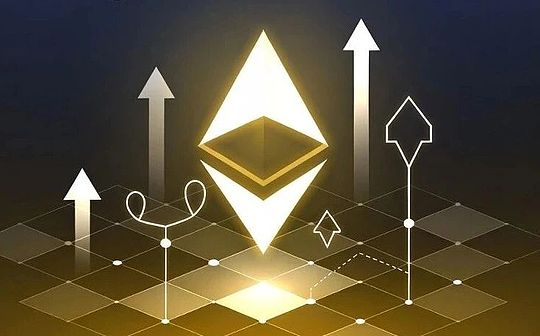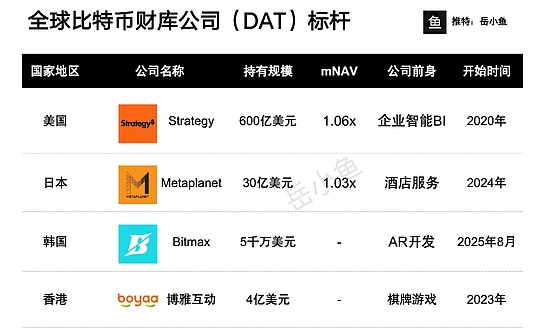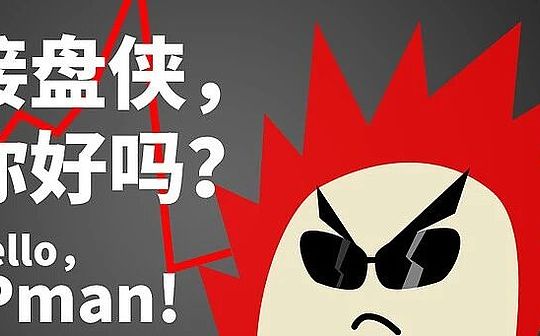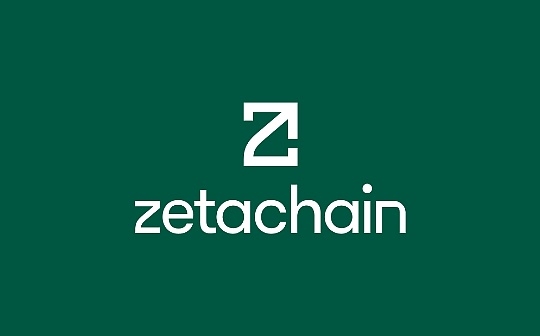
Author: Zetachain; Translation: Bitchain Vision Xiaozou
1Key insight
-
ZetAChain is a Layer-1 (L1) blockchain, which provides chain-agnostic interoperability through its full-chain contract service.It allows applications developed on Zetachain to connect to any other application or blockchain.
-
ZetAChain uses the COSMOS SDK and Tendermint consensus mechanism to enable developers to construct a customized interoperable blockchain.
-
The network also has an execution layer compatible with the Ethereum virtual machine (EVM), called ZEVM.Developers can choose between the full -chain contract (bridge connection different blockchain) and cross -chain message transmission (CCM, transmitting data and value information across blockchain).
-
Zetachain’s full -chain application introduces far -reaching chain drawing functions.Recent measures, such as Sushi’s native Bitcoin support, highlights that the Bitcoin market in Defi is far from being developed.
-
Zeta is the native currency of Zetachain, which will be used to pay GAS fees, call smart contracts, and through pledge guarantee network security.Once Zeta is released, the holder can earn rewards through pledged token.
2Background introduction
ZetAChain was launched by an anonymous team on December 15, 2021. The team members have the work experience of Coinbase and Basic Attention token (BAT).Several previous coinbase employees were the project consultant of Zetachain, including Nathalie McGrath, the first manpower leader of Coinbase and Juan Suarez, who had been a 10 -year consultant in Coinbase.On March 9, 2022, the team released the ZetAChain White Paper and Devnet, and completed the initial seed wheel financing, and the amount of fundraising was unknown.The round of investors include Dan Romero, Sam Rosenblum, John Yi, JD Kanani and Hwisang Kim.ZetAChain completed the second round of financing in August 2023. Lingfeng Capital, GSR and other investors to raise 27 millionDollar.
The ZetAChain Test Network was released in August 2022, and then quickly attracted a large number of users to participate. The number of users in the first month after the release reached 150,000.By March 2023, a million user milestones will be reached, which coincides with the launch of verification incentives.Zetachain continued to test the operation of the network stage. As of December 19, 2023, the official release date of the main network has not been announced.
3As well asZetAChainOverview
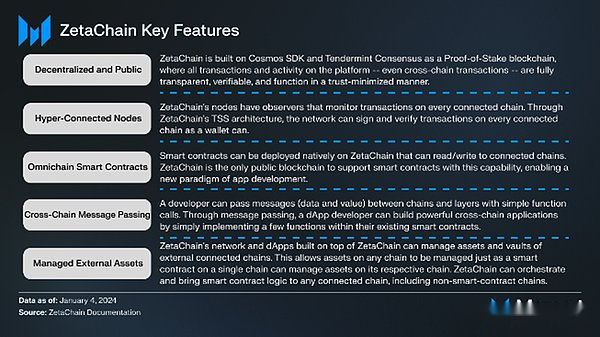
ZetAChain is a L1 blockchain that can realize interoperability between unrelated chains.The network focuses on only about 5 seconds and the final certainty, without the ability to confirm or reorganize transactions.Applications developed on Zetachain will be able to connect to any other application or blockchain to provide a single access point for Web3 and existing encrypted users and existing encrypted users.This is achieved by using the full -chain smart contract. These contracts can read and write any other blockchain, even those blockchain that is not native to use smart contracts.Developers can also use Zetachain’s Connector to send data and value messages to any chain through simple functions.
4, Technology and architecture
(1.EVMlayer
The ZetAChain network is compatible with the Ethereum virtual machine (EVM), named ZEVM.This layer supports EVM functions, such as the creation, interaction and combination of smart contracts.It also allows the external chain to be transferred to a contract built on Zevm.The ZEVM contract can also create a station transaction on the blockchain connected to the ZetAChain.All developers who develop and build on Zetachain will create ZEVM contracts (the standard Solidity contract).However, in order to maximize the network function, the ZEVM contract must either follow the specific requirements of the full -chain contract or use cross -chain messages to pass.
(2) All -chain contract
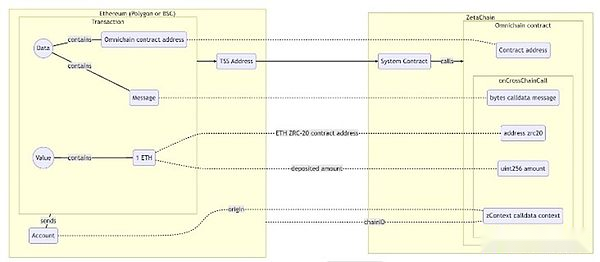
The full -chain contract must be executed by cross -chain calls, and it only needs to be deployed on Zetachain, and then the external chain can be connected.The connected chain can also transfer digital assets to the contract address on Zetachain.The asset transferred to Zetachain uses the ZRC-20s tokens.All -chain contract supports high -efficiency deployment of existing popular agreements on Ethereum, such as Uniswap and AAVE.They can also integrate with the network (such as Bitcoin) that are not compatible with smart contracts.The GAS fee generated by the full -chain contract uses the native GAS token settlement of the target chain.
In short, the full -chain contract on the Zetachain provides a future -oriented cross -chain function, which has a deployment and can be accessed across all integrated networks.This model uses the synchronous execution environment, and any new chain supports supported by Zetachain can be instantly compatible, thereby avoiding the trouble of re -deploying or coding for different blockchains.Therefore, the full -chain contract is a cross -chain interaction bond, which improves the user experience by minimizing the cross -chain GAS fee.
The main advantage of the full -chain contract is that they can achieve a unified state and execution.In CCM and other similar systems (such as Layerzero and Axlar), applications that are not uniform in state usually require complex solutions.However, the full -chain contract supports a unified single state to ensure the smooth operation of most use cases.Through the maximum reduction of the GAS fee of the station and the target transaction, it does not depend on multiple messages. The full -chain contract can be used as a native accessable supplement for CCM.
(3) Cross -chain message transmission
Cross -chain message transmission (CCM) is an alternative to the full -chain contract.CCM is used to convey data and value messages between blockchain, while Zetachain is a middleman.Developers deploy the full -chain contract on Zetachain, while the contract that enables CCM is deployed on the external chain.Then call the ZetAChain Connector API. Zetachain forwards the message to the target chain and enables the CCM contract to receive the message from the target chain.The state is stored in a set of contracts that enable CCMs on different chains.
CCM is useful for applications that only need one -way and asynchronous logic/effect without (or not benefit) unified state.The main purpose of CCM is to enhance existing applications on the external chain through cross -chain function.The GAS fee generated by the CCM contract is to be priced at the ZETA token, and it must be sent to the Connector contract on the source chain.
ZetAChain also uses the Burn/Mint mechanism to protect the security of digital assets transferred using CCM contract transfer.Assets are bunges on the source chain and cast on the target chain.This mechanism is more secure than the bridge or packing (wrapping), because these methods hold transfer assets.
5, Consensus mechanism
ZetAChain is an open source framework developed and constructed using the COSMOS software development toolkit (SDK) to build unauthorized public rights certificate (POS) blockchain and licensed authoritative certificate (POA) blockchain.COSMOS SDK helps developers to build a new blockchain, and publish, test and integrate networks after creation.
COSMOS SDK provides a modular framework that can customize new blockchains for specific user needs.It also supports parallel chain operations to meet the throughput of throughput with the increase of user needs.Since the COSMOS SDK ensures interoperability, it allows digital assets and its value to transfer and flow between different blockchains built by the framework.It also supports the consensus module of equity and decentralized governance achieved through community proposals and voting.In addition to these functions, the SDK also includes security measures such as firewalls to ensure the security of blockchain applications.Because of its many functions, COSMOS SDK has been used to build some famous applications and blockchains, such as BNB Chain, DYDX, OSMOSIS, and Celestia.
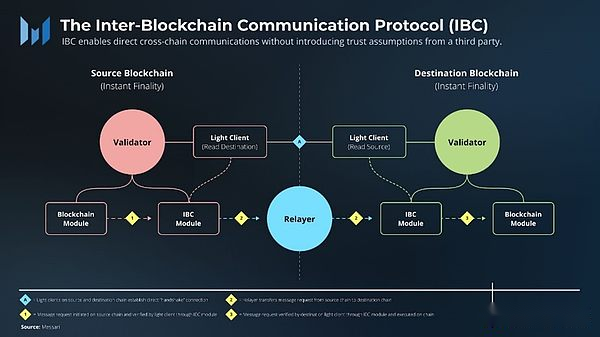
Tendermint’s consensus mechanism is an asynchronous Byzantine (BFT) state machine operated by Validator (verification).The verifications take turns to propose and vote on the transaction block.In each height of the chain, a block is proposed. If the proposed block is not approved by other verifiables, the new verifications will be the high proposal block.To obtain approval, two stages of voting must be passed.These two stages are called “pre -votes” and “pre -ordering”. When more than two -thirds of the verifications voting weights are approved in the same round of voting, this block is finally confirmed.
The voting weight is determined by the asset fender weight of each specific blockchain price.As far as Zetachain is concerned, verifying node operators must pledge the Zeta tokens.Since ZetAChain is a Zeta token holder who entrusts the rights and interests to the blockchain and does not operate the verification node, the Zeta tokens can entrust the Zeta token to the existing verificationrs.The ratio of tokens (commission and self -pledged) controlled by a single verification person to the total number of tokens controlled by all verifications determines the pledge weight, and then decides the voting weight.
The specific architecture is as follows:
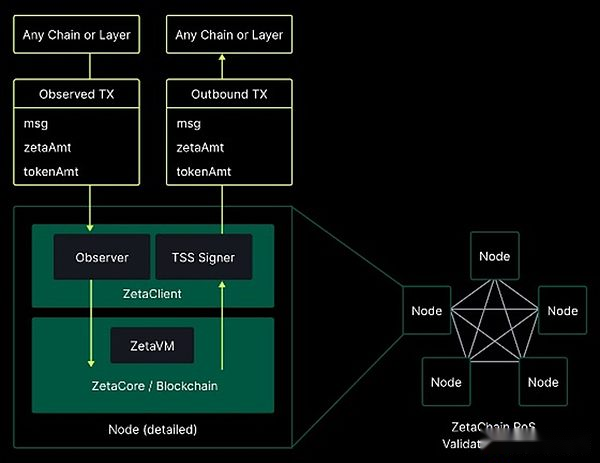
The architecture of ZetAChain is mainly composed of a decentralized verification. The verifier network reaches a consensus on external state and events, and is responsible for updating the external chain status through a distributed key signature.Each verificationr node contains a Zetacore and ZetAclient, which are tied together and run by the same operator.Zetacore generates a block in the blockchain and maintains a copy of the status machine, while the ZetaClient observes the incidents on the external chain and signed a transaction sent to these chains.
ZetAChain’s verifications may be the signatures of Basic Validator, Observer or Threshold Signature Scheme (TSS).
(1.Basic Validator(Basic verification)
Basic verifications have a specific consensus key, responsible for voting the block proposal, and the voting right is obtained through pledged Zeta.Basic verifications need to always be online and can participate in block production.In addition, the two verification nodes of the operator and TSS signature also need to run basic verification nodes.In contrast, as far as software and hardware requirements are concerned, the cost of running Basic Validator is much less.
(2.Observer(Observer)
Observer is responsible for the incident and status of the external chain to reach a consensus.Observer monitor transactions, events, and status on the specific address of the full -node operation of these external chains.
Such verifications can be further divided into Sequencer (sorting) and Verifier (verification) characters.Sequencer observed related external behavior and reported the information to Verifier. Verifier then verified and voted to ZetAchain to achieve a simple majority consensus on external behavior.In order to make this process effective, a lot of verificationrs are required to participate; however, only a Sequenceer reports to the verification person.
(3.Threshold Signature Sigoners(Signature signature)
TSS signatures on Zetachain hold part of the ECDSA/EDDSA key.The threshold signature scheme (TSS) is a digital signature verification method for multi -party computing (MPC) cryptography.In MPC, the private key is generated by the “key fragment”, and each key fragment is held by a separate party or node.TSS allows the use of private keys when reaching the set key fragment threshold without requiring all key fragments.For example, if there are 9 people holding key fragments and 5 setting thresholds, as long as 5 of the 9 key fragments holders provide the key fragments they hold, they can use private keys.
The keys used for authentication with the external chain are stored in the entire Zetachain, and distributed to multiple signatures according to the above TSS method.The tokens pledged by ZetAChain using verifications as mortgages against malicious validators to ensure that TSS signatures will not sign messages on the external chain on behalf of ZetAchain.
(4) Architecture challenge
There are some inherent risks in the modular system architecture.These systems may increase complexity, security challenges and composable dilemma, and may also bring greater complexity to developers.ZetAChain’s full -chain method seems to solve many such problems, but the deep -rooted underlying problem in the multi -chain world may limit the needs of Zetachain and its solutions.
Similarly, Zetachain may face similar risks that have been repeatedly faced with the bridge over the years.The keen analysis of bridges and interoperability -related risks will help better protect the platform because it bets its product service to the future of an interconnected blockchain.
Although the POS mechanism of Zetachain provides a powerful security model, it is also possible to create a network of over -reliance on a small part of the verification.In other words, the cycle selection system of Zetachain may be a balance, even if its efficacy has not been fully evaluated.ZetAChain is not the only one who faces the dilemma facing reliable and active verifications, which can be seen from the relatively low Satoshi coefficient in general.
6As well asZetaToken
Zeta is the native currency of Zetachain, which will be released with the ZetAChain main network.When writing this article, the specific release date has not been announced.Once Zeta and the main network are released, the token will be mainly used to pay GAS fees, call smart contracts, and pledge to ensure network security.
Verifications and token holders will be able to pledge Zeta and get rewards.Zeta will also become the main value transfer on Zetachain, which supports the use of a one -way hook mechanism to transfer between the connected blockchain.Under this mechanism, the number of transferred Zeta tokens will be dropped on the source chain and casts on the target chain.The pledge parameters have not been specified, but the project has listed hardware requirements for running verification nodes.No information on the total supply or specific allocation of Zeta has been released.The project team claims that Zeta will be one of the first multi -chain tokens issued across multiple chains and layers.
7, Ecological system
In today’s multi -chain world, users need more and more seamless interaction across the network.Multiplication users may find that they are attracted to the full -chain methods advocated by Zetachain, rather than shuttle between bridges, chains, wallets and other requirements.This paradigm transition reduces trading friction and enhances security, and at the same time provides developers with the freedom of deploying applications on the most suitable chain.
Zetachain’s emerging full -chain application field shows this potential through the introduction of chain abstraction.SUSHI’s native Bitcoin support and other measures highlight that the Bitcoin market within the DEFI is far from being developed, especially considering the recent discussion around Bitcoin ETF.In addition, it is recommended to support the development of Web3, DEFI, and SocialFi applications through ZRC-20 standards of Zetachain.As of October, the Zetachain ecosystem has 150 applications.As shown in the infrastructure diagram below, the Zetachain ecosystem has expanded to cover various types of participants in different fields.
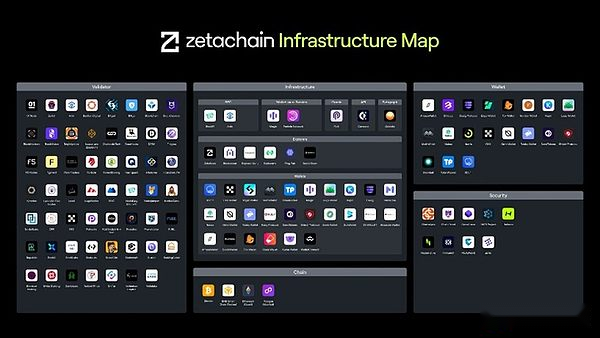
As mentioned earlier, the Zetachain test network has 150,000 users in the first month after release in August 2022.In less than a year, the number of users has increased to 1 million, which is a milestone, coincided with the launch of verifications incentives.As of writing this article, the test network has processed 37.6 million ZEVM transactions and 14 million cross -chain transactions from over 2.5 million ZEVM’s unique addresses.
8, Competitive pattern
As Zetachain open up its niche market in the field of blockchain, it will have to deal with two forms of competition.First of all, the correlation of Zetachain may be affected by the result of the dispute between the single chain and the modular blockchain.Compared with the cross -chain ecosystem, Ethereum has a significant leading advantage in users, developers and liquidity.But in addition, Zetachain is also facing the inherent competition from participants.
(1.Axlar
Axlar was created by the same basic COSMOS SDK as the underlying technology of ZetAChain.Axlar is committed to full stack interoperability. This is an overall method that includes not only asset bridge connections, but also the execution of cross -chain smart contracts and DAPP support without permission.The Axlar community has adopted three parts of strategies to expand its connected network (currently 55).The economic structure reorganization, the AXELAR virtual machine deployment for the non -friction connection, and the pursuit of a more streamlined solution (such as the light client) promoted the expansion of the network connection.Compared with the comprehensive but complicated system of Axlar, the unified execution environment provided by Zetachain allows users to enjoy a more concise experience. The GAS cost is lower and better meets the needs of message transmission.
(2.Layerzero
Unlike Axlar, Layerzero stands out from Zetachain because of its infrastructure.It is not a blockchain, so it provides developers with greater flexibility for developers in terms of agreement implementation.Nevertheless, Layerzero relies on centralized Oracle and Relayer, which requires a higher degree of trust, especially because it runs on the physical multi -signing system under the dual chain.Therefore, Layerzero may experience complexity in the interoperability of its CCM type, just like Axlar and other similar chains.In contrast, ZetAChain is expected to make itself a potentially minimize alternative due to its chain operation.
(3.Thorchain
ThorChain is another direct competitor of Zetachain. It has a native integration with the COSMOS ecosystem and uses a similar blockchain development toolkit.Like Zetachain, Thorchain is committed to interoperability and promotes asset flows between different blockchain; however, it uses unique mechanisms to focus on liquidity and security, creating a unique niche market.
ThorChain is a protocol based on automatic city merchants (AMM), similar to UNISWAP, but it is different.All the assets in the ThorChain system are paired with its native asset RUNE.In this way, ThorChain creates a DEX that prevents the fragmentation of liquidity between each pool and ensures that any assets on Thorchain can be exchanged with any other assets.In contrast, Zetachain can use its more decentralized verifications mechanism, a wider compatibility chain, or relatively loose requirements for node operations.In addition, ThorChain is specific to the application, while ZetAchain is a general smart contract platform.This allows Zetachain users to not only compete directly with ThorChain, but also surpass DEX applications to build other applications and use cases.
9,in conclusion
All in all, ZetAChain aims to provide seamless connections and accessability for Web3 applications.To achieve this goal, it uses its L1 blockchain infrastructure, COSMOS SDK and TENDERMINT consensus algorithm.With its full -chain smart contract and cross -chain message transmission function, Zetachain enables developers to connect and interact with any blockchain, including those blockchains that do not support smart contracts.
As an entrusted equity certificate, Zetachain will further decentralize through its token Zeta.In addition to protecting network security, Zeta will also be used to pay GAS fees, and it is still the main value transfer.As Zetachain is getting closer to the main network, it has the potential to promote interoperability and enhance the broader blockchain ecosystem function.
Although the potential of Zetachain is huge, the road to success is not without challenges.When writing this article, Zetachain is still a relatively new L1, which has not yet launched the main network.Like all blockchain, it is a difficult task to achieve mainstream adoption, especially when the existing competitors are very powerful.
According to the recent roadmap, the ZetAChain team plans to focus on increasing the adoption rate of users and developers.This route map emphasizes more chain integration, achieve greater interoperability between different DAPP and different asset types (especially support for Bitcoin NFT), and provide SDK for the full -chain DAPP developers.At the same time, the team will study how to improve the security and efficiency of Zetachain through some functions of the network.
In the end, compared with the key areas of Axlar, Layerzero, and Thorchain, Zetachain should highlight its unique selling points in the competition -such as its structure, verification mechanism or transaction efficiency.In this way, Zetachain can effectively “circle land” in the market and use it to bring greater value to users to occupy a place in competition.

